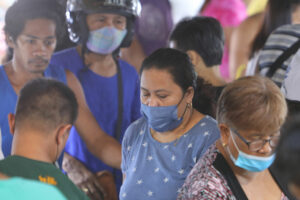COVID positivity rate up in 12 Philippine provinces

By Kyle Aristophere T. Atienza, Reporter
THE CORONAVIRUS positivity rate has fallen in Manila and nearby Philippines cities but has increased in some provinces, according to a group of local researchers.
The so-called percent positive in the capital region fell to 15% on Oct. 8 from 17.9% on Oct. 11, according to a bulletin sent by Fredegusto P. David, a fellow from the OCTA Research Group, on Thursday.
It rose in 12 provinces including Tarlac in northern Philippines where the rate was the highest at 51.8%, OCTA said. It was followed by Camariñes Sur, whose positivity rate rose to 46.2% from 37.1%.
Zambales, Cavite, Rizal and Laguna on Luzon island and South Cotabato in the country’s south also posted high positivity rates of 20% to more than 30%, it said.
The Philippines posted 1,623 coronavirus infections on Wednesday, bringing the total to 3.97 million.
There were 24,283 active cases and 63,363 deaths, according to data from the Department of Health (DoH). About 3.89 million patients have recovered.
Metro Manila had the highest number of new cases in the past two weeks with 11,198, followed by Calabarzon with 5,349, Central Luzon with 2,753, Davao region with 1,431 and Western Visayas with 981 infections.
Meanwhile, the Health department said the new Omicron subvariant XBB had not been detected in the Philippines.
The XBB variant is a recombinant of Omicron subvariants BA.2.10.1 and BA.2.75, DoH said in a statement.
The new sublineage showed higher “immune evasion ability” than the highly infectious BA.5, it added, citing preliminary studies.
Coronavirus cases were first reported in Wuhan, China in December 2019. The Philippines posted its first infection on Jan. 30, more than a week after a Chinese who tested positive for the virus arrived in the country.
China has been struggling to contain a fresh surge in infections after a seven-day holiday that increased people’s mobility.
On Wednesday, the state newspaper People’s Daily said China would continue to implement its COVID-19 policies to avoid “losing control” of local outbreaks.
“Only by insisting on dynamically clearing (cases as they arise) could huge losses arising from losing control of the epidemic be avoided by the full extent,” the state newspaper wrote.
“Once epidemic prevention and control is relaxed, a large number of people will be infected within a short period of time, a large number of severe cases and deaths will occur, resulting in a run on medical resources,” it added.
China on Wednesday posted 1,760 coronavirus infections for Oct. 11, lower than 2,089 infections a day earlier.
The Philippines, which had struggled to contain four infection waves, has relaxed most restrictions including the mask mandate outdoors.
Philippine President Ferdinand R. Marcos, Jr., who took office in June, has yet to appoint a Health secretary.
DoH on Tuesday said it had detected 722 more Delta and Omicron subvariant cases. There were 605 new BA.5 Omicron subvariant cases based on sequencing results from Oct. 7 to 10.
Ninety-three new Delta cases were also detected, while a case was still being verified. The agency said 18 cases of BA.4 and five cases of BA.2.75 were recorded.
The coronavirus has sickened 628.5 million and killed 6.6 million people worldwide, according to the Worldometer website, citing various sources including data from the World Health Organization (WHO). More than 607 million people have recovered.
The United States had the most infections at 98.7 million with 1.1 million deaths, followed by India with 44.6 million cases and 528,847 deaths, and France with 36 million cases and 155,675 deaths.




